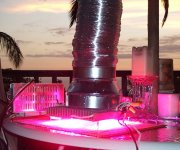After 20 years growing indoors, two years ago I decided to replace my old lighting kits (Sodium lamps with magnetic ballasts and adjust-a-wings) with COBs.
Theoretically, one can replace 600W of sodium with 400 W of Cree or Citizen high quality COBS and get the same amount of weed. At the same time, electricity bill and heat generated reduces.
So I built some kits I bought with Citizen and Cree chips. I replaced 600W sodium with 600 Watt COBs and I chose 3500ºK for all purpose grow, to be used both in flower and in vegetative.
After a couple of years getting used to the cobs, I can say the next positive things I enjoyed:
-I got a better production per watt
-Plants mature between a week and ten days earlier than with Sodium.
-I got less heat, so ventilation needs are reduced.
-Better light distribution and homogeneity.
-Bushier plants. They stretch very little and the distance between branches is kept to a minimum. Branch grow is encouraged and vertical growth limited. It is magic for the extreme sativas that I grow.
-Stronger plants. Stems and branches are stronger.
But I am aware also of some aspects I hope I knew before. There are some questions that can make the change to LEDs a little tricky. These are my impressions. Some are due to the technology, but another can be caused by the specific temperature I used (3500ºK)
-The buds lose bag appeal. In some way, they are leafier than those of the same strains under high pressure.
-Vegetative growth is slower. I don't know if it happens because the lower temperatures in winter (COBs don't heat as much as sodium) or just because they provide different spectrum that doesn't stimulate vertical growth.
I wanted to upgrade my setup, but now I believe that I'll get better results with some sodium mixed with my LEDs instead rising the power with more LEDs. I think that LED anti-stretch spectrum is very nice to be used during the first 1-3 weeks of stretch to avoid explosive growth, but some red and heat from the sodium can help compact the buds during the next weeks.
I think that is clear that 3500ºK is not the right color temperature for flowering, but I doubt that 3000ºK is going to make a big difference.
Some ideas? Thanks
Theoretically, one can replace 600W of sodium with 400 W of Cree or Citizen high quality COBS and get the same amount of weed. At the same time, electricity bill and heat generated reduces.
So I built some kits I bought with Citizen and Cree chips. I replaced 600W sodium with 600 Watt COBs and I chose 3500ºK for all purpose grow, to be used both in flower and in vegetative.
After a couple of years getting used to the cobs, I can say the next positive things I enjoyed:
-I got a better production per watt
-Plants mature between a week and ten days earlier than with Sodium.
-I got less heat, so ventilation needs are reduced.
-Better light distribution and homogeneity.
-Bushier plants. They stretch very little and the distance between branches is kept to a minimum. Branch grow is encouraged and vertical growth limited. It is magic for the extreme sativas that I grow.
-Stronger plants. Stems and branches are stronger.
But I am aware also of some aspects I hope I knew before. There are some questions that can make the change to LEDs a little tricky. These are my impressions. Some are due to the technology, but another can be caused by the specific temperature I used (3500ºK)
-The buds lose bag appeal. In some way, they are leafier than those of the same strains under high pressure.
-Vegetative growth is slower. I don't know if it happens because the lower temperatures in winter (COBs don't heat as much as sodium) or just because they provide different spectrum that doesn't stimulate vertical growth.
I wanted to upgrade my setup, but now I believe that I'll get better results with some sodium mixed with my LEDs instead rising the power with more LEDs. I think that LED anti-stretch spectrum is very nice to be used during the first 1-3 weeks of stretch to avoid explosive growth, but some red and heat from the sodium can help compact the buds during the next weeks.
I think that is clear that 3500ºK is not the right color temperature for flowering, but I doubt that 3000ºK is going to make a big difference.
Some ideas? Thanks





